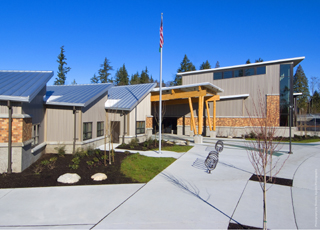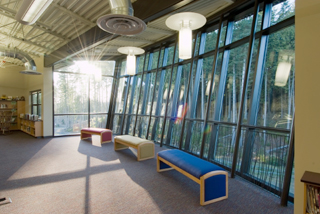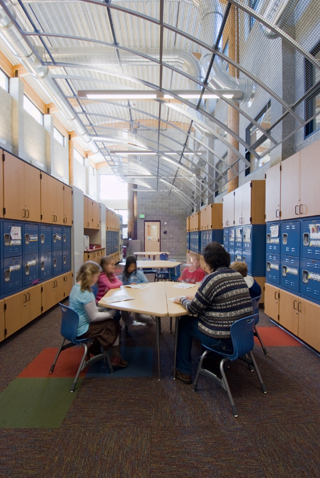
DJC.COM
August 28, 2008
Nature’s obstacles force fresh thinking in Everett
Dykeman

Twietmeyer
|
When Everett Public Schools recently set out to build Forest View Elementary School, it not only had to decide where it should go, but whether it should use the same design prototype it used for its last four elementary schools.
Large, level parcels of land were in short supply at the time. Yet the prototype was a single-story complex of five buildings around an enclosed courtyard, requiring a significant amount of land.
The district looked at the available inventory of land, including its own, and concluded it would be best to build on a parcel it already owned, north of its existing Gateway Middle School site.
The site presented some real challenges for the prototypical school layout due to wetlands, substantial grade changes and an existing stream.

Photos by Timothy Aguero Photography Forest View Elementary’s flexible design includes modules for classrooms, group areas and administrative spaces.
|
Rather than trying to make the prototype fit on the site, the ultimate solution was to develop a new prototypical program, one that would allow the building form to vary in ways that could be manipulated to fit this site and others in the future.
Dykeman worked closely with the district to develop the elements of the prototypical program, including the classroom modules, the administrative module and the cafetorium/kitchen/gym module. These elements were carefully sited in a curving “daylit basement” sort of scheme, with the two-story portion looking out over the stream gully and across to the forested woodland on the other side.

The two-story layout accommodates the site’s grade changes and allows forest views from each classroom. |
The main circulation corridors within the building are oriented parallel to the forest edge. Three prototypical classroom modules then “plug” into the meandering corridor, each level consisting of four classrooms surrounding a common breakout space.
A clerestory at the upper level of the circulation core provides a source of daylight for the interior of the building, and allows natural light from two sides of each classroom.

An upper-level clerestory provides a source of daylight for the interior. |
A two-story solution was proposed to accommodate the grade change and allow a view of the forest from each classroom. Wood poles and glu-lam beams were used in the main circulation space to further connect the interior with the exterior. Exterior landscape design provides two outdoor classrooms, allowing incorporation of the site into the curriculum.
A new east-west and north-south road was required to serve the school. The undulating topography required a fair amount of earthwork to accommodate the building pad areas, parking and playfields. The design team worked to balance the cut and fill required for both the roadways and the terraces for the schools.
Using a flexible kit of program elements will allow the district to plan other schools on potentially challenging sites.
Tim Twietmeyer is a principal with Dykeman Architects, where he has been a member of the school studio team.
Other Stories:
- Can good design boost the case for school consolidation?
- Spend more now to save big in the long run
- Green goals guide UW’s Architecture Hall renovation
- What the future holds for school design
- UW building to get B-school students mingling
- Colleges expand to meet health care demand
- Northwest University answers call for nurses
- A science building that goes easy on energy
- The next generation of American schools
- 7 questions project managers should ask about BIM
- Tribal schools expand role preserving native cultures
- Mount Rainier inspires Orting Middle School design
Copyright ©2009 Seattle Daily Journal and DJC.COM.
Comments? Questions? Contact us.